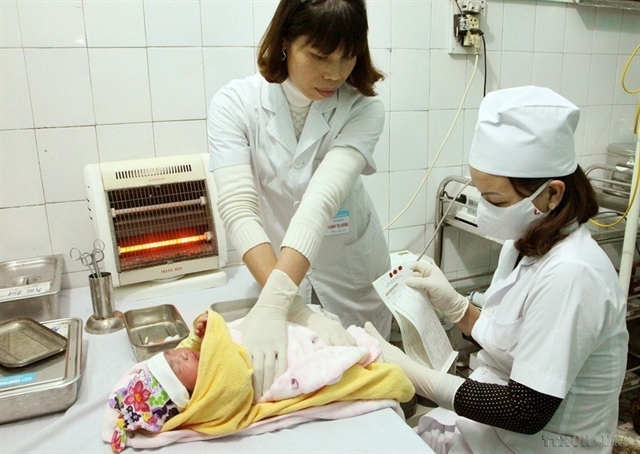 |
| Medical workers take blood from a newborn’s heel to screen for birth defects at the Lạng Giang District Hospital in the northern province of Bắc Giang. — VNA/VNS Photo Dương Ngọc |
HÀ NỘI — Việt Nam is still in the ageing population process and is one of the countries with the fastest ageing rate in the world, said Minister of Health Đào Hồng Lan.
She said that a prolonged low birth rate would lead to many consequences, such as labour shortages and impacts on social security.
Recently, voters in HCM City suggested having specific measures to increase the birth rate in urban areas.
Minister Lan answered that Việt Nam officially reached the replacement fertility rate since 2006, but the replacement fertility rate was not really sustainable.
The total fertility rate nationwide is showing a downward trend below the replacement level, from 2.11 children per woman in 2021 to 2.01 children per woman in 2022 and 1.96 children per woman last year. It was the lowest decline since 2006 and is forecast to continue.
The decline is concentrated in certain urban areas with advanced socio-economic conditions and high urbanisation:
- In urban areas, the birth rate has been below the replacement level for the past 20 years and is consistently lower than in rural areas.
- Two out of six socio-economic regions (Southeast and Mekong Delta) have birth rates below the replacement level. The Southeast region, including HCM City, which has the highest per capita income in the country, also has the lowest birth rate, with an average of 1.47 children per woman.
- Out of 63 provinces and cities, 21 have low birth rates, accounting for approximately 39.37 per cent of the national population. Most of these provinces are located in key economic regions of the southern area, characterised by high urbanisation and rapid economic growth.
According to the Ministry of Health, a prolonged low birth rate will lead to various consequences such as a rapidly ageing population, labour shortages, and impacts on social welfare. The decreasing birth rate not only affects population size but also results in a lower proportion of children under 15 years old and a higher proportion of elderly people.
Solutions
On April 28, 2020, Prime Minister Phạm Minh Chính issued Decision No 588/QD-TTg approving the Programme on Adjusting Birth Rates to Suit Regions by 2030.
Under the decision, localities that have reached replacement fertility and have low fertility rates need to support and encourage people to have two children.
Localities will analyse and evaluate policies on labour, employment, housing, social welfare, education, health to develop and implement appropriate intervention models.
Provinces and cities should found friendship clubs to encourage young people to make friends, provide health advice before marriage, encourage them to marry before the age of 30 and have children early, while women should have a second child before 35 years old.
They should pilot and expand worker-friendly services such as child drop-offs and pick-ups, babysitting, breast milk banks and family doctors.
Localities should focus on building childcare centres and kindergartens, especially in economic and industrial zones and urban areas.
Women will be supported during pregnancy, childbirth and giving birth, including infertility screening, prenatal and postnatal screening and malnutrition prevention.
Couples with two children will be helped to buy social housing or to rent, they will get priority admission to public schools and help with children’s education costs.
Provinces and cities will promote communication about the benefits of having two children, the disadvantages of getting married and having children too late or of having too few children for socio-economic development and for the family itself.
One noteworthy item that the health minister recalled from the Prime Minister’s decision in the list of policies is to “step by step pilot increasing the responsibility to contribute to society and community to individuals who don’t want to get married or get married too late,” although this has not been clearly defined. — VNS
- Reduce Hair Loss with PURA D’OR Gold Label Shampoo
- Castor Oil Has Made a “Huge” Difference With Hair and Brow Growth
- Excessive hair loss in men: Signs of illness that cannot be subjective
- Dịch Vụ SEO Website ở Los Angeles, CA: đưa trang web doanh nghiệp bạn lên top Google
- Nails Salon Sierra Madre
 VnExpress News The News Gateway of Vietnam
VnExpress News The News Gateway of Vietnam





